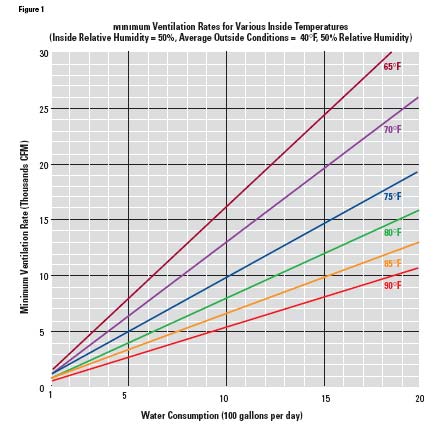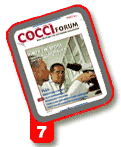Technically Speaking
Guest Author Provides Technical Insights on Managing Coccidiosis in Broilers
 Michael Czarick
Extension Engineer
University of Georgia
Athens
|
The hazards of poorly managed
litter are well known to poultry
producers. Too little moisture
can result in dehydration and respiratory
illness. Too much moisture leads to
litter caking and ammonia, which causes
a host of problems ranging from
blindness to poor flock uniformity.
Good litter management is essential
when it comes to managing coccidiosis.
Wet litter sets up an ideal environment
for the proliferation of coccidial
oocysts, increasing the challenge to
birds and the risk for coccidiosis outbreaks.
In birds vaccinated against coccidiosis,
some exposure to coccidia is needed
to stimulate immunity. If the litter is
too dry, there might not be enough
oocyst sporulation to stimulate immunity
and make vaccination effective. To
adequately stimulate the coccidial life
cycle and immunity, a minimum of 25%
litter moisture content is needed.
On the other hand, if the litter is too
wet and oocyst sporulation is too high,
birds could be overwhelmed with coccidial
challenge before immunity is
fully developed. Wet litter can set the
stage for development of necrotic
enteritis (Clostridium spp.) since bacteria
thrive in a moist environment.
Considerations
When devising a plan to control litter
moisture, keep in mind that birds are
continuously adding moisture to the
house. As a general rule, birds drink
almost two pounds of water (about one
quart) for every pound of feed they eat.
If 24,000 four-day-old birds eat approximately
1,000 lbs. of feed daily, they
will drink close to one ton of water
daily. As birds get older, feed consumption
increases dramatically "and
so does the amount of water they
drink. By the end of a 7-week growout,
a house with 24,000 birds has consumed
over 100 tons of feed and well
over 200 tons of water! Where does it
all go? Less than a third of ingested
water is retained by the birds. The rest
is exhaled into the air in the form of
water vapor or deposited into the litter.
When a grower operates exhaust
fans, the moisture-laden air in the
house is replaced with drier outside air,
thereby removing water from the
house. The drier air that the fans bring
into the house will not only pick up
water that the birds are placing into the
air but also remove water from the litter,
keeping it drier. Of course, if a producer
does not operate exhaust fans
enough, water will build up in the air
as well as litter leading to house sweating
and litter caking.
It's all relative
When it comes to removing moisture
from a house, it is important to know
that the amount of water that air can
hold varies dramatically depending on
temperature. The term humidity is used
to describe how much water is in the
air. For instance, if the humidity is
100%, we know the air is holding all
the water it can. If the humidity is 90%
the air can only pick up a little water
from the litter and litter caking is more
likely to occur. If the humidity in a
house is 40%, it is capable of picking
up a lot of water from the litter.
Because the amount of water the air
can hold changes with the temperature,
relative humidity is a better term than
humidity. For instance, 1,000 cubic feet
of 40°F air can only hold less than eight
ounces of water, but 1,000 cubic feet of
85°F air can hold about 32 ounces. At
150°F, 1,000 cubic feet of air can hold
an entire gallon of water. The fact that
hot air can hold more water than cold
air is why we use hot air when we
want to dry something off, such as wet
clothes in a clothes dryer.
As a general rule, the moisture-holding
ability of air doubles for every 20
degree rise in temperature. If 1,000
cubic feet of 40°F air has 100% relative
humidity, it holds approximately 6
ounces of water. If the temperature of
that air is increased by 20 degrees, the
moisture-holding ability of the air doubles
and it can now hold about 12
ounces of water. Since the air now has
only half the water it's capable of holding,
the relative humidity is 50%.
Let's heat the same 1,000 cubic feet
of air another 20 degrees to 80°F. There
is still only less than 6 ounces of water
in the air, but now the air is capable of
holding about 24 ounces of water.
Therefore, the air is only holding 25%
of the water it can, and the relative
humidity is 25%.
So, can you dry a house when it is
cold and rainy outside? Yes you can,
because as you warm the air to the
proper house temperature you are
increasing its moisture-holding ability
and the relative humidity of the air
decreases. Since the air can now hold
more water, it can remove more water
from the litter, keeping the house drier.
The key to drying cold wet air is to
make sure that all incoming air is
brought in through air inlets that directs
the air toward the ceiling. As the fresh
air moves along the ceiling, it is heated
by the hot air produced by the birds
and brooders/furnaces that tends to
collect at the ceiling due to the fact that
hot air is lighter than cold air. The
longer that incoming air can be kept at
the ceiling through maintaining the
proper static pressure and inlet opening,
the more the air will heat up and
dry out. Maximum heating and drying
of air is obtained if the static pressure
and inlet openings are set so that
incoming air stays at the ceiling until it
has reached the center of the house.
Circulation fans
Another way to promote litter moisture
control is through the use of small circulation
fans that are 18 to 24 inches in
diameter. Circulation fans can help
bring in drier air from the ceiling gently
down to floor level; water is picked
up from the litter, which keeps the
house drier. Of course, if exhaust fans
are not operated enough, moisture in
the air and litter can build up.
Circulation fans, if operated properly,
should not cause a draft at bird
level. Generally, they should be controlled
with an interval timer or variable
speed controller. Interval timer settings
or speed can be adjusted according to
house conditions. If there is significant
temperature stratification or the litter
needs additional drying, timer settings
or the speed of fans can be increased.
If the litter is very dry, the use of circulation
fans can be decreased.
How much ventilation?
To determine how much fresh air is
needed, use the chart (see Figure 1)
that provides the required minimum
ventilation rate to get rid of moisture. It
is based on how much water the birds
are consuming, the inside house temperature
and an average daily outside
temperature of 40°F. The minimum
ventilation rates that are determined
from the chart should be viewed as a
starting point that may need to be
increased or decreased according to a
variety of factors such as the type of
waters used and how tightly the house
is constructed.
One of the best ways to figure out if
adjustments are needed to minimum
ventilation fan settings is to monitor
relative humidity in the poultry house.
Ideally, relative humidity should be
between 50% and 70%. If it is below
50%, the litter may become too dry and
minimum ventilation fan settings
should be decreased. If the relative
humidity is above 70% for a prolonged
period, litter caking and house sweating
can occur and minimum ventilation
fans settings should be increased.
Practical examples
Let's look at some examples of how to
keep litter dry based on what we've discussed
so far. Say a producer has older
birds "which produce bigger, wetter
droppings and are kept in lower temperatures
than younger birds "that the
house temperature is 70° F and the relative
humidity is 65%. You start noticing
that the litter is getting a little damp and
want to dry it out before it slicks over.
First, you try turning down the timer
fan thermostats to 65°F to bring in more
air. Since the air temperature is lower,
the moisture-holding ability of the air
decreases, and the relative humidity
would increase to about 78%. This will
make it more difficult to remove water
from litter. Yes, you would bring in
more air, which would help to some
extent, but the downside is that higher
relative humidity will make it more difficult
to pull out water from litter.
In contrast, let's say we increase the house
temperature just 3° and leave the timer
fan settings the same. The relative
humidity will decrease to approximately
58%, making it significantly easier to
draw water out of the litter.
Another option would be to leave
the house temperature the same and
turn up the timer fan settings. This
would work provided we do not let the
house temperature fall. In some
instances, this means adding heat to the
house to maintain the desired house
temperature. The key to keeping a
house dry is the quality, not quantity, of
air. Bringing in a lot of cold air and letting
the house temperature fall usually
is not as effective as bringing in a moderate
amount of air and warming it up.
Contrary to common belief, using
warm air to dry out litter does not
always mean increased heating costs.
As outside temperatures increase during
the day, the moisture-holding ability
of the air increases. Take advantage
of that fact. During the day when the
sun is out and the air temperature is
warmer, increase timer fan settings to
capitalize on relatively drier air.
 |
Seasonal challenges
Cold weather is considered a time of
year when controlling litter moisture is
a big challenge, but hot weather can
present problems too. Even though
evaporative cooling pads and fogging
nozzles can decrease air temperature in
a house by 10° to 20°F, they can also
raise the relative humidity of the air to
above 80%. Why? For every one degree
of cooling produced by an evaporative
cooling system, the relative humidity of
air will increase by about 2.5%.
Excessively high house humidity can be
minimized by making sure that evaporative
cooling pad/fogging systems are
set to operate no lower than 82°F.
There's one other important way
that excessive litter moisture can be
kept to a minimum, and that's by making
sure that the evaporative cooling
system does not operate after 10pm or
before 9am in the morning. These are
times when outside humidity typically
is above 80%, which limits the amount
of cooling to be produced by pads and/
or fogging systems. When evaporative
cooling systems are operated between
10pm and 9am, they do little to cool the
air and tend to saturate incoming air
with moisture, increasing the chance of
excess litter moisture and all its inherent
problems.
Source: CocciForum Issue No.7, Schering-Plough Animal Health.







